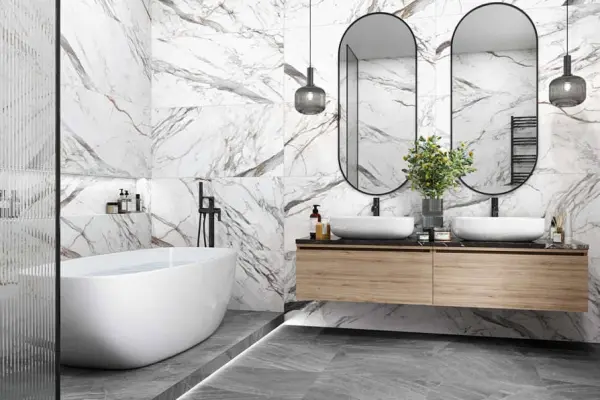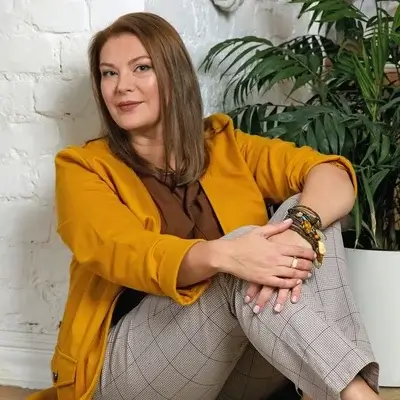In this article, we will explore current trends in modern bathroom design, analyze European approaches to layout, and share practical tips for creating a functional and aesthetically pleasing space.
Functional bathroom design, in its advanced understanding, combines technological solutions with classic ergonomic principles. In 2025, the average cost of a bathroom renovation in Europe ranges from $1,800 to $12,500, depending on the project's scope. It’s worth noting that property owners are increasingly striving to create an ergonomic bathroom design that harmoniously blends technical excellence with visual aesthetics. This approach transforms an ordinary space into a personal relaxation zone — like a miniature home spa center.
Current Trends in Bathroom Design
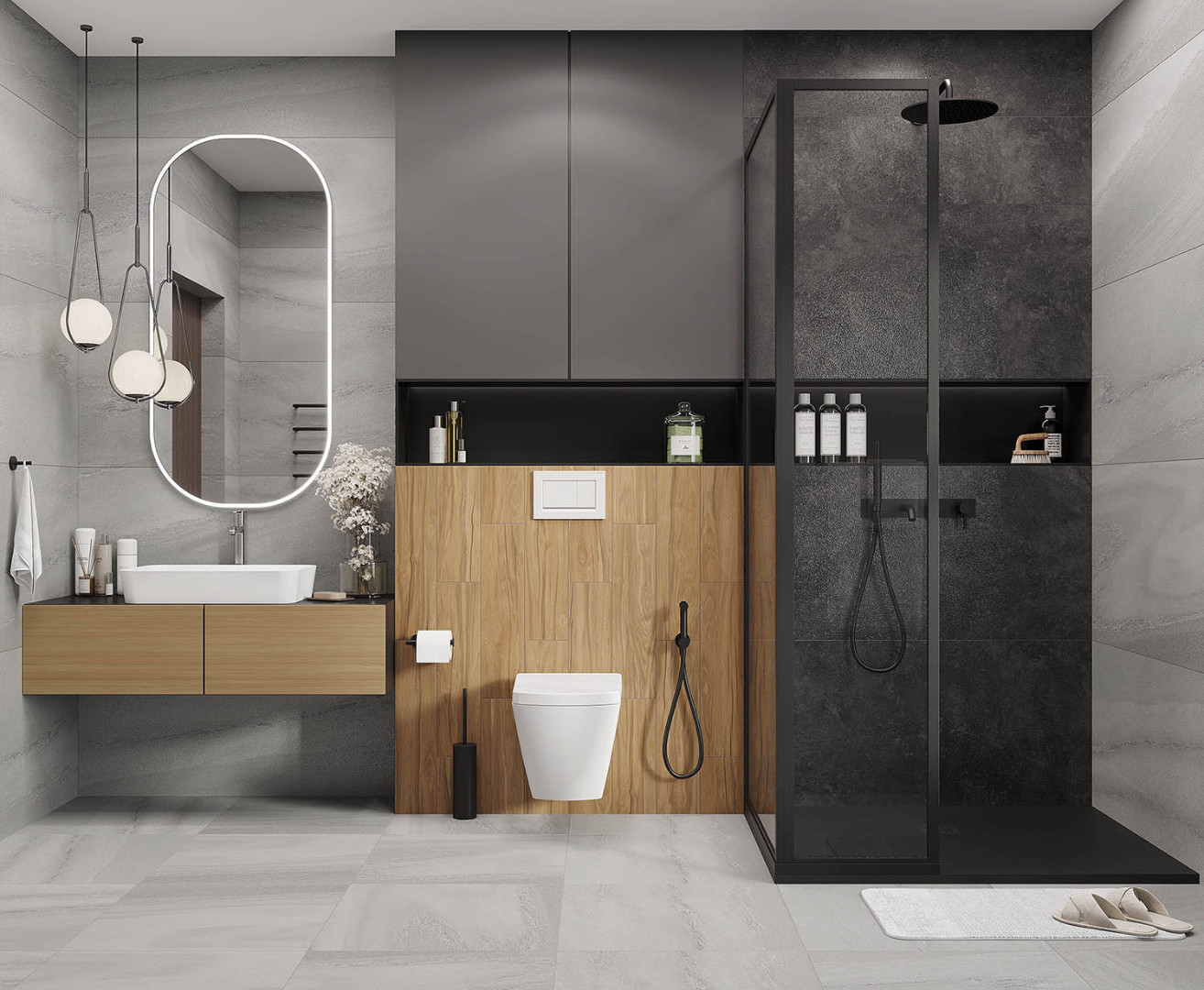 Scandinavian minimalism continues to dominate international bathroom design. Functionality takes precedence over decorativeness.
Scandinavian minimalism continues to dominate international bathroom design. Functionality takes precedence over decorativeness.
According to studies by the European Association of Interior Designers, sustainability significantly influences current trends in sanitary space design. In one recent project, the use of eco-friendly materials reduced energy consumption by 35%.
Data from the European Interior Design Council shows that 82% of professionals prioritize practical solutions for bathrooms. Biophilic bathroom design is gaining popularity among European homeowners seeking harmony with nature. Matte surfaces in bathrooms appear more organic than artificial materials. An eco-friendly bathroom is not only a 2025 design trend but also a responsibility toward future generations.
According to the European standard EN 16798-1:2019 "Energy Performance of Buildings," optimal bathroom layout should consider anthropometric data: a minimum distance of 75 cm between sanitary fixtures for comfortable movement, a sink installation height of 80-85 cm to the top edge, and a minimum bathroom area of 2.5 m².
Color Solutions for Bathrooms: Balancing Aesthetics and Practicality
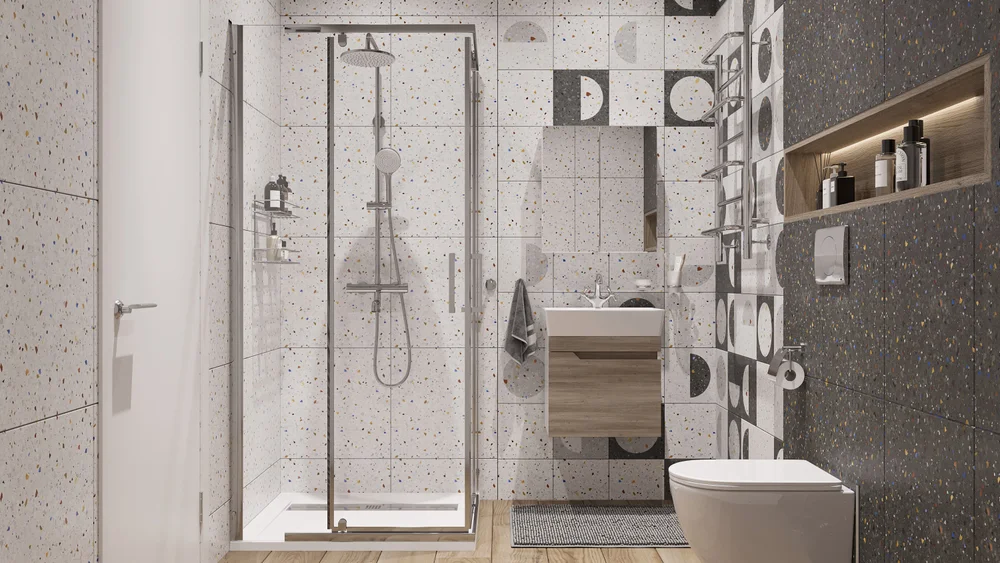 A monochromatic palette remains a leading trend in modern bathroom design. White, gray, and beige are the primary colors of conceptual bathroom design, visually expanding the space.
A monochromatic palette remains a leading trend in modern bathroom design. White, gray, and beige are the primary colors of conceptual bathroom design, visually expanding the space.
In one recent project, a combination of light marble with natural oak elements exceeded the client’s expectations. It is well-known that a properly selected color scheme impacts users’ psychological well-being.
Which shades should you choose for a stylish bathroom? It’s important to consider that vibrant tones are suitable only for spacious areas of 12 square meters or more. Light bathroom finishes visually enlarge even the most compact spaces — like an optical illusion in action.
| Color Group | Psychological Effect | Application Area | Harmonious Combinations |
|---|---|---|---|
| White and Cream | Visual space expansion | Base wall and ceiling covering | Graphite, natural wood |
| Gray Shades | Modernity, stability | Accent surfaces | White, brass, marble |
| Beige Tones | Warmth, comfort | Flooring, furniture | Brown, ivory |
| Natural Green | Freshness, eco-friendliness | Decorative accents | White, wood, natural stone |
This classification will help determine the optimal color concept for your bathroom design project, considering both aesthetic and functional aspects.
Bathroom Layout and Functional Zoning
A rational bathroom starts with professional zoning. A smart bathroom involves clear division into functional zones: hygienic, storage, and relaxation.
Western ergonomic studies confirm the importance of proper space allocation for comfortable use. In practice, I often notice that improper bathroom zoning leads to chaos in daily use.
Suspended plumbing is a consistent global design trend. It creates a sense of lightness and simplifies room cleaning. Given the structural features of modern construction, suspended systems are installed in 65% of new bathroom design projects.
The principle of the ergonomic triangle: the optimal placement of key elements — bathtub, sink, and toilet — should ensure unobstructed movement. Recommended triangle dimensions: sides from 150 to 240 cm. Detailed ergonomic bathroom planning criteria account for potential health and safety risks for users.
Bathroom Storage Organization: A Systematic Approach
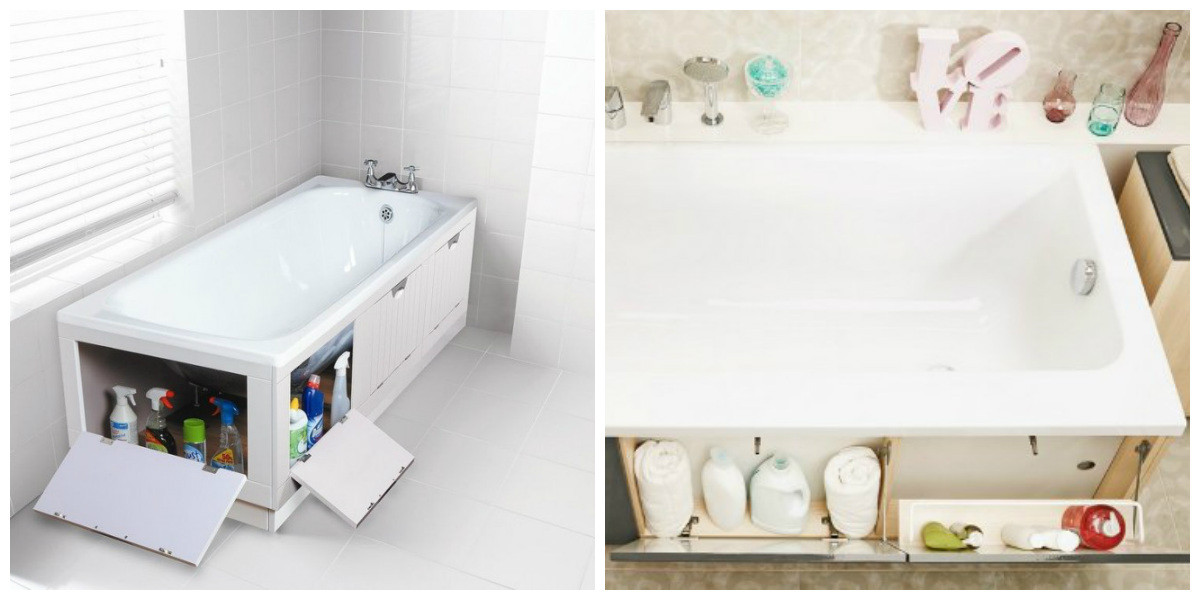 Organizing bathroom space requires a creative approach. Built-in storage systems save space more effectively than traditional solutions.
Organizing bathroom space requires a creative approach. Built-in storage systems save space more effectively than traditional solutions.
In practice, it’s often observed that homeowners underestimate the importance of well-thought-out bathroom storage, leading to functional issues later. It’s not always obvious at first glance but is critically important for comfort.
Bathroom furniture should be multifunctional. Mirror panels can conceal spacious compartments. A sink vanity is not just a support but a full-fledged storage system for cleaning products and bath accessories, capable of holding all daily essentials with proper planning.
- Mirror modules enhance the visual perception of space
- Corner designs maximize the use of available space in small bathrooms
- Sliding mechanisms provide convenient access to contents
- Wall-mounted bathroom accessories free up working surfaces
- Built-in appliances in the bathroom save usable space
These ready-made bathroom solutions contribute to creating an elegant bathroom without visual clutter.
Current Materials and Finishing Technologies
Moisture-resistant materials are the foundation of a durable bathroom renovation. Porcelain tiles maintain a leading position among flooring options.
It has been established that high-quality bathroom tiles last 20-25 years without losing performance characteristics. In one recent project, a client chose inexpensive ceramic tiles costing $15 per square meter — within two years, a full replacement was needed due to microcracks and loss of appearance.
Natural stone creates a luxurious atmosphere in large bathrooms but requires professional maintenance and is not always economically justified. An alternative is porcelain tiles mimicking natural stone, which, with proper installation and treatment, offers the practicality of advanced technologies while preserving the aesthetics of natural materials.
According to the European standard EN 14411:2016 "Ceramic Tiles," tiles with a water absorption rate of less than 0.05% are recommended for wet areas. For flooring, choose materials with anti-slip properties of class R9-R10. High-quality waterproofing of the bathroom base and walls up to 250 cm in the shower area is mandatory.
Bathroom Lighting: Technical Requirements and Design Solutions
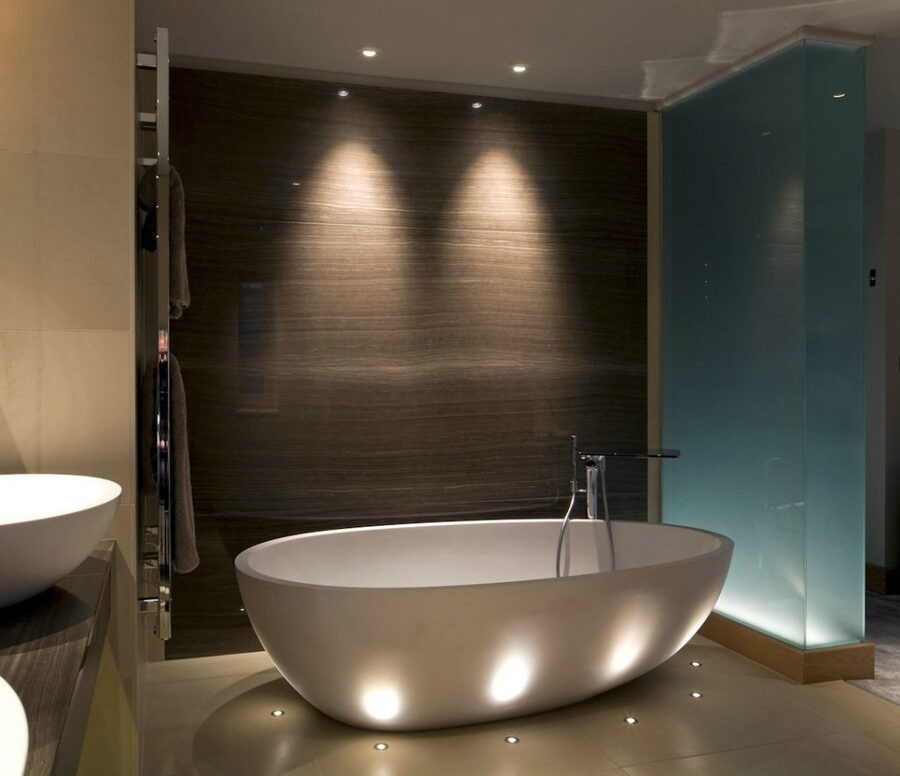 Multi-level bathroom lighting is the foundation of a comfortable atmosphere. General lighting is complemented by targeted illumination, while decorative elements highlight the room’s architectural features.
Multi-level bathroom lighting is the foundation of a comfortable atmosphere. General lighting is complemented by targeted illumination, while decorative elements highlight the room’s architectural features.
Developing a proper bathroom lighting concept requires professional expertise, but the results far exceed expectations. Thus, quality lighting becomes not just a technical solution but a tool for creating ambiance.
According to the European standard EN 12464-1:2011, the minimum bathroom illumination is 200 lux, with 300-500 lux recommended. LED technologies save up to 70% of electricity, with a lifespan of 25,000-50,000 hours in high-humidity conditions — like a beacon of durability in an ocean of technical solutions. Investments in quality lighting pay off in 1.5-2 years, and a modern bathroom gains not only functional but also outstanding aesthetic qualities.
Electrical safety requirements per IEC 60364-7-701: in zone 0 (inside the bathtub) — voltage up to 12V DC; in zone 1 (60 cm perimeter around the bathtub) — IP44 protection class, with a mandatory 30mA RCD for all electrical circuits in the sanitary space.
Plumbing Equipment: Expert Choices
 Walk-in shower systems are replacing traditional cabins in trendy bathrooms. A freestanding bathtub becomes the compositional centerpiece of spacious sanitary spaces.
Walk-in shower systems are replacing traditional cabins in trendy bathrooms. A freestanding bathtub becomes the compositional centerpiece of spacious sanitary spaces.
Thermostatic faucets ensure safety and efficient resource use — like smart guardians of comfort. It’s worth noting that the right choice of plumbing impacts the entire bathroom interior.
How to choose plumbing for a functional bathroom? International manufacturers offer solutions with warranties up to 20 years, while budget alternatives require replacement every 7-10 years.
Investment in reliable plumbing pays off in 4-6 years due to water savings and minimal maintenance costs. European manufacturers guarantee a lifespan of up to 20 years for faucet equipment.
A washing machine in the bathroom requires special placement planning. Accessories should harmonize with the overall room style. A towel radiator serves not only a decorative but also a critical climatic function, maintaining an optimal microclimate in the space.
Common Mistakes in Choosing Plumbing Equipment
Saving on faucet equipment is a common mistake. Low-quality fittings fail within 3-4 years.
In one project, a client insisted on budget faucets costing $110 — the result was a leak and the need to dismantle the cladding to replace hidden pipes. The savings proved illusory.
Incorrect sizing of a bathtub or shower system is also critical. An overly large bathtub in a compact space creates a sense of imbalance. It’s known that the optimal bathtub-to-room area ratio is 1:8, ensuring comfortable movement and visual harmony.
Bathroom Renovation Planning: From Concept to Implementation
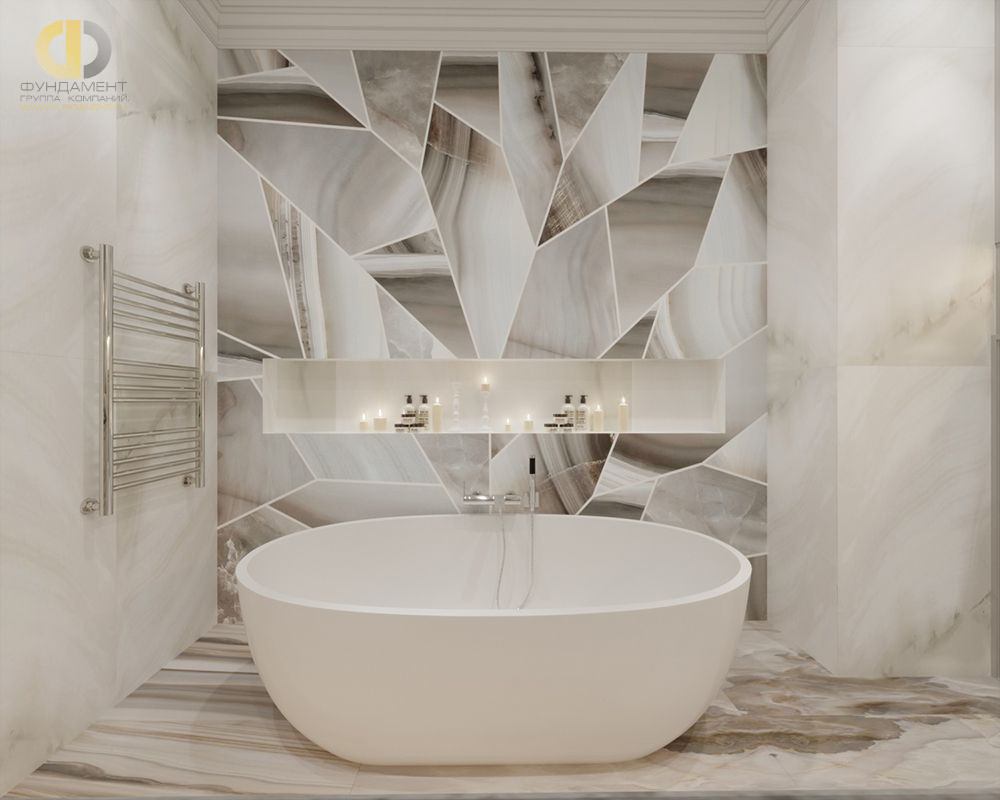
Comparison of Budget and Premium Solutions
Choosing between economical and high-end materials should be based on analyzing cost, quality, and durability. This ensures investments are justified rather than spontaneous.
| Component | Budget Solution | Premium Solution | Expert Recommendation |
|---|---|---|---|
| Floor Tiles | Ceramic $18-33/m² | Porcelain $52-98/m² | Porcelain in wet areas |
| Faucet Equipment | $98-180 | $420-825 | Mid-range $180-330 |
| Bathtub | Acrylic $270-525 | Artificial stone $1800-3300 | High-quality acrylic $525-900 |
| Lighting System | LED panels $52-113 | Designer fixtures $330-900 | High-quality adjustable LED |
The optimal strategy is to invest in durable plumbing equipment and save on decorative elements.
Top 7 Bathroom Renovation Mistakes
Analysis of numerous projects reveals a pattern: most issues stem from recurring mistakes.
Understanding these points will help avoid costly rework when creating a practical bathroom. It’s worth noting that being forewarned is being forearmed.
1. Violating the Technological Sequence of Work
Many start by purchasing plumbing equipment and then adapt the bathroom layout to it.
The correct approach is different: first layout, then materials, and finally equipment. This algorithm creates a harmonious bathroom interior without compromises or extra costs.
Practical experience shows that those who plan thoroughly save up to 30% of time and financial resources. There’s no need to rush — it’s better to plan carefully.
Structure of the Budget by Main Categories
Rational budget allocation is the foundation of a quality result without financial surprises. Considering the structural specifics of each project, it’s important to reserve funds for unforeseen expenses.
| Expense Category | Budget Share | Approximate Amount ($) | Category Contents |
|---|---|---|---|
| Materials and Finishes | 42% | 750-5100 | Tiles, paints, waterproofing |
| Installation Work | 33% | 600-4200 | Demolition, installation, finishing |
| Plumbing Equipment | 20% | 360-2500 | Bathtub, toilet, sink, faucets |
| Reserve for Unforeseen Expenses | 5% | 90-625 | Reserve for adjustments |
This structure helps control expenses and avoid exceeding the initially planned budget for a practical bathroom design.
2. Inadequate Bathroom Waterproofing
Poor waterproofing causes 70% of neighbor disputes, according to insurance statistics. Durable materials cost an additional $113-180 but prevent thousands of dollars in damages to others’ property.
Professional recommendation per international standards: use elastic polymer waterproofing in the shower area, extending 25 cm up the walls. In other areas, brush-on waterproofing is sufficient. Ensure corners and joints are sealed with elastic tape with a 12 cm overlap.
3. Underestimating Ventilation Importance
Ineffective bathroom ventilation leads to mold and unwanted odors. Per the European standard EN 15665:2009 "Building Ventilation," minimum exhaust capacity is 35 m³/hour for a bathroom, plus 70 m³/hour for a combined bathroom-toilet.
Considering room specifics, a standard 5 m² bathroom requires an exhaust capacity of 105-140 m³/hour. Skimping on ventilation leads to health issues.
4. Incorrect Choice of Grouting Materials
Standard grout in wet areas lasts 2-3 years. Epoxy grout, four times more expensive, lasts 12-15 years.
Savings are dubious: regrouting costs far exceed the initial price difference. The math is simple and unforgiving.
5. Ignoring Ergonomics and Building Codes
Attractive design without usability is a common bathroom design mistake. Per EN 16798-1:2019, a sink height of 80-85 cm is optimal for most users.
A 25-35 cm distance to the mirror ensures comfortable use. The minimum passage width is 75 cm, with 90 cm being comfortable. These parameters impact daily comfort in a cozy bathroom.
6. Improper Electrical System Planning
Insufficient outlets or incorrect placement cause operational inconveniences. Per IEC 60364-7-701, a bathroom should have at least two outlets outside wet zones.
Preferably with USB ports for modern devices. In 2025, this is no longer a luxury but a necessity.
7. Neglecting Base Quality
An uneven base leads to tile cracking and waterproofing failure. Floor leveling with self-leveling compounds adds $22-38 per m².
But it ensures the durability of the entire covering. Saving on preparation leads to rework.
Eco-Friendliness and Energy Efficiency
An energy-efficient bathroom reduces operating costs by 35-45%. Water-saving equipment pays off in 4 years. LED lighting lasts 15 times longer than traditional bulbs. According to BBC Earth studies, bathrooms have the greatest environmental impact among all home spaces, despite their compact size.
A proven ventilation system prevents mold and preserves family health. Plants in the bathroom act as natural air purifiers, creating a home spa atmosphere and natural freshness.
| Eco-Friendly Solution | Annual Savings | Payback Period | Environmental Impact |
|---|---|---|---|
| LED Lighting | $38-61 | 1.5 years | 150 kg CO2 reduction |
| Water-Saving Faucets | $98-143 | 4 years | 3500 liters water saved |
| Energy-Efficient Ventilation | $68-113 | 5 years | Improved air quality |
| Smart Control Systems | $83-128 | 6 years | Automated energy consumption |
These data demonstrate the real benefits of implementing eco-friendly technologies in bathroom design.
Recommendations for Choosing Manufacturers and Brands
Selecting reliable materials and plumbing equipment is an investment in the longevity of a bathroom interior. In one recent project, a client insisted on saving costs — within 1.5 years, the faucet equipment needed complete replacement.
Trusted Plumbing Equipment Brands
The mid-range segment offers the optimal price-to-quality ratio:
- Grohe — German faucet technology, 7-year warranty
- Hansgrohe — pioneer in shower systems
- Villeroy & Boch — designer European-level plumbing
- Duravit — functional solutions for advanced bathrooms
Budget segment with acceptable quality:
- Geberit — Swiss reliability in installation systems
- Roca — Spanish brand with a robust service network
- Laufen — Austrian quality ceramic products
Recommended Finishing Materials
For finishing materials, technical characteristics are critical, not just aesthetic qualities. Thus, choices should be reasoned, not emotional.
| Material Type | Recommended Manufacturers | Key Characteristics | Cost $/m² |
|---|---|---|---|
| Porcelain Tiles | Porcelanosa, Marazzi, Villeroy & Boch | Water absorption <0.05%, R9 | 27-83 |
| Waterproofing Materials | Mapei, Sika, Weber | Elasticity, crack resistance | 9-18 |
| Grouting Mixtures | Mapei Kerapoxy, Sopro, Ardex | Epoxy base, 12-15 year lifespan | 12-27 |
| Moisture-Resistant Paints | Dulux, Caparol, Benjamin Moore | Moisture resistance, antimicrobial properties | 6-14 |
Investments in durable materials pay off in 4-6 years due to longevity and no need for major bathroom renovations.
Requirements for Heating Systems and Bathroom Microclimate
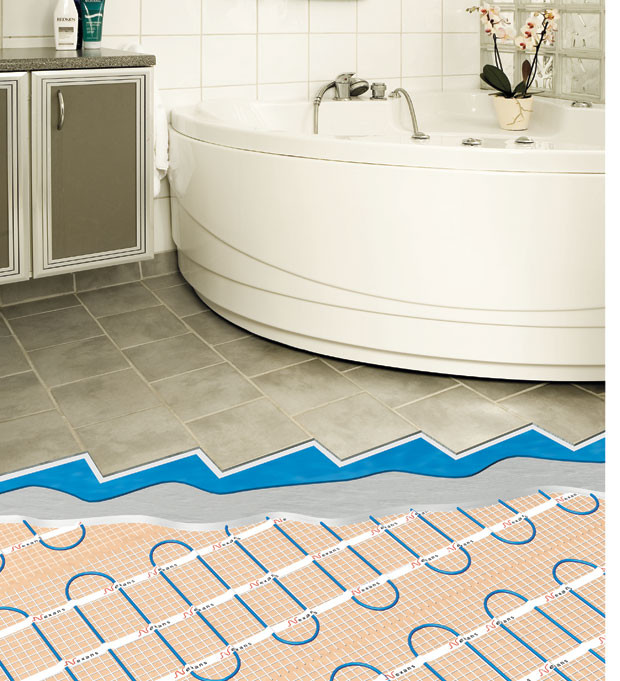 According to the European standard EN 16798-1:2019, the optimal bathroom temperature is 22-24°C, with relative humidity of 40-60%. Underfloor heating systems should maintain a surface temperature of 24-27°C.
According to the European standard EN 16798-1:2019, the optimal bathroom temperature is 22-24°C, with relative humidity of 40-60%. Underfloor heating systems should maintain a surface temperature of 24-27°C.
It’s established that a properly designed heating and ventilation system prevents condensation on mirrors and metal surfaces. Space clustering helps create comfortable microclimatic zones.
Universal bathroom design accounts for the needs of people with limited mobility per EN 17210:2021. Passage widths increase to 100 cm, with handrails and anti-slip coatings provided. A barrier-free bathroom is care for the future.
Technological Solutions in Bathroom Design
Smart technologies are transforming advanced bathrooms. Touchless faucets save water and ensure hygiene. Mirrors with heating and built-in lighting enhance functionality.
Smart home systems allow control of lighting, temperature, and ventilation via mobile apps. In practice, I often notice that owners underestimate automation’s potential until they experience it firsthand.
Digital Solutions for Advanced Smart Bathrooms
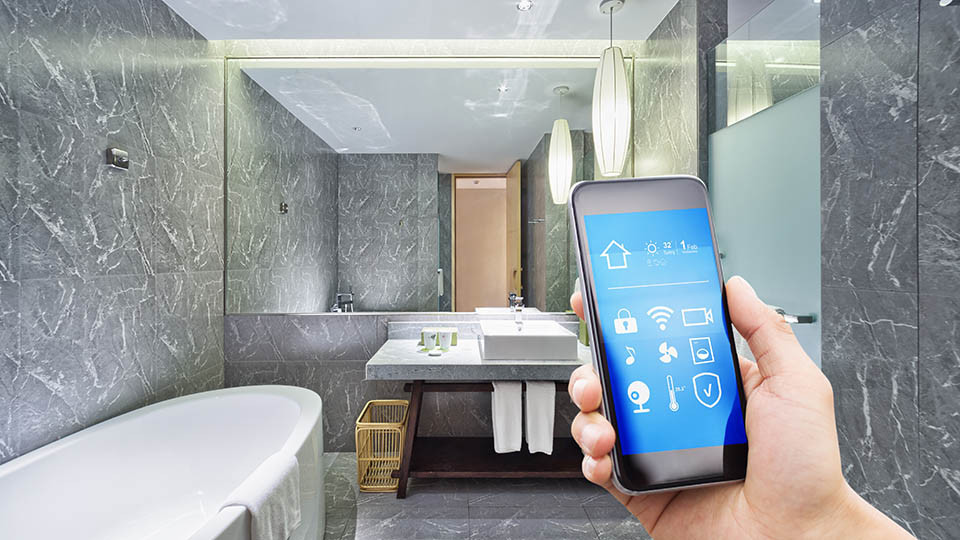 Integrating digital technologies into bathroom design opens new possibilities for comprehensive bathroom styling:
Integrating digital technologies into bathroom design opens new possibilities for comprehensive bathroom styling:
- Touch control for lighting and ventilation
- Thermostatic shower panels with programmable modes
- Mirrors with integrated displays and Bluetooth connectivity
- Automatic soap and disinfectant dispensers
- Humidity control systems with mobile monitoring
These technologies not only enhance comfort but also promote resource efficiency and hygiene. The future is already here — it’s just a matter of using it.
Lighting Planning: Technical Aspects
Professional bathroom lighting requires a comprehensive approach. General lighting should ensure even light distribution. Task lighting at the mirror requires 300-500 lux.
Decorative lighting creates a relaxing atmosphere in a cozy bathroom. It’s worth noting that proper lighting affects color perception and the overall mood of the space.
| Lighting Type | Purpose | Recommended Power | Fixture Type |
|---|---|---|---|
| General Lighting | Main room illumination | 200-300 lux | Ceiling LED panels |
| Task Lighting | Sink and mirror area | 300-500 lux | IP44 side fixtures |
| Accent Lighting | Decorative illumination | 50-100 lux | LED strips, built-in fixtures |
| Night Lighting | Safe movement | 10-20 lux | Floor LED lighting |
A smart combination of lighting types creates a comfortable and functional light environment for professional bathroom design.
Bathroom Design and Planning Services
Hiring professionals for bathroom design ensures not only a beautiful interior but also a technically sound solution. It’s known that DIY planning leads to rework and extra costs in 55% of cases.
In one project last season, owners tried to save on bathroom design — resulting in $3,200 in additional costs to fix planning errors. The savings proved illusory.
Comprehensive Bathroom Design Services
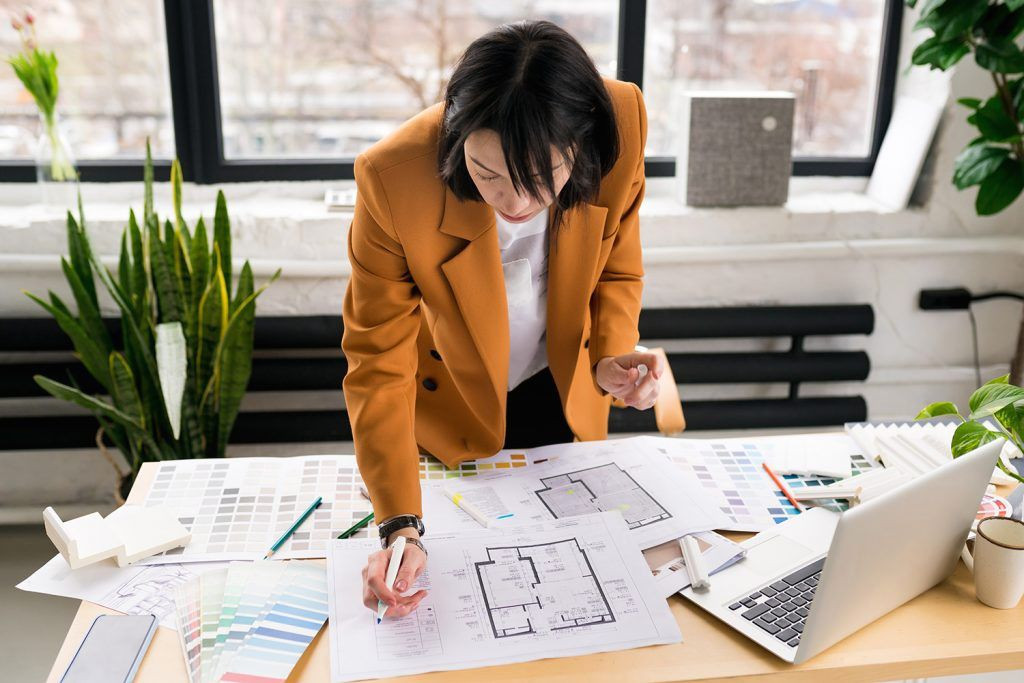 Professional bathroom design includes all stages, from concept to supervision:
Professional bathroom design includes all stages, from concept to supervision:
- Technical inspection and room measurements
- Layout development considering bathroom ergonomics
- 3D interior visualization for result clarity
- Material and plumbing selection within budget
- Bathroom lighting and ventilation design
- Supervision of work execution
- Project warranty service
This approach avoids planning errors and delivers a result that delights for years. The cost of bathroom design is justified by execution quality.
Conclusion
Modern bathroom design is a balance of functionality, aesthetics, and technological solutions. A successful project requires a comprehensive approach: from proper space planning to selecting durable materials and equipment.
Investments in professional bathroom design and reliable materials pay off through daily comfort and lasting results. Remember: a practical bathroom is not just about beauty but also about health, resource efficiency, and environmental responsibility.
We hope the recommendations and practical tips in this article will help you create your dream bathroom, delighting with functionality and beauty for years to come.
